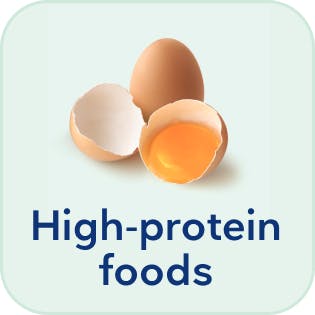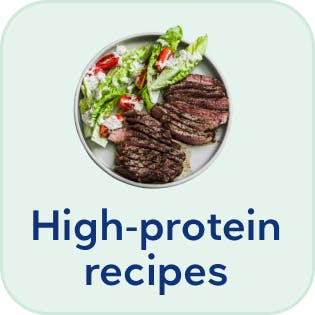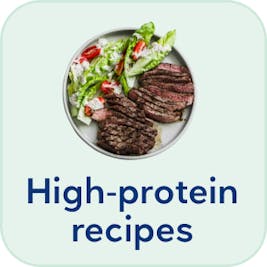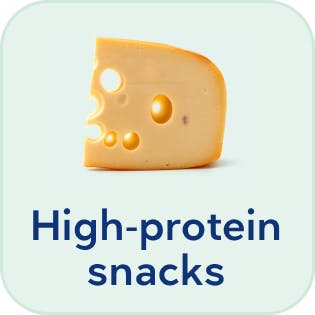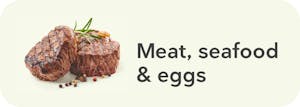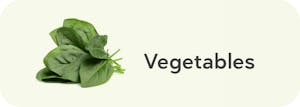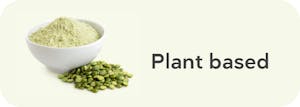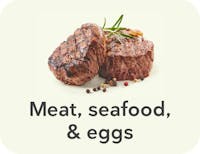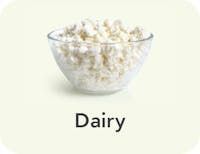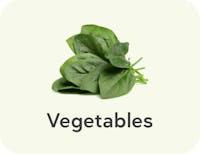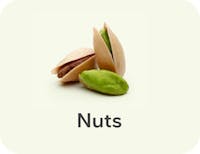High-protein diet:
What it is and how to do it
You may have heard that high-protein diets can help with weight loss and metabolic health. That’s why, at Diet Doctor, we feature high-protein recipes and meal plans. But how do you know if a higher protein diet is right for you?
This guide will explain what high-protein diets are, help you find the best high-protein foods, and explore the potential benefits of high-protein diets.
Key takeaways
What are the best high-protein foods?Meat, seafood, eggs, beans, and dairy are all great sources of protein.
Find out if your favorite foods are also high protein.
What can high protein do for you?
You can lose weight, improve your health, and gain muscle by adding protein to your diet.
Learn more about how high protein could benefit you.
How much protein do I need?
More than you probably think! But it’s easy to add more protein to your diet with a few simple tricks.
Find them here.
1. What is a high-protein diet?
A high-protein diet is one where you work on getting plenty of protein — probably more than you are used to getting — as the first focus of your eating patterns. Protein-rich foods include eggs, meat, seafood, legumes, and dairy products. These foods are not only high in protein but high in nutrients in general. That means a high-protein diet is also a high nutrition diet.
Increasing protein can be very helpful for weight loss because protein can help tame your appetite.1 It also supplies plenty of the raw materials needed to maintain your muscles and your metabolism, both of which help ensure that you’re burning calories at an appropriate rate.2
For people who want to build muscle, getting more protein than is typically recommended is a must. Current recommendations, known as the RDA or the recommended dietary allowance, are designed for “healthy people” and meant to prevent malnutrition; they aren’t meant to help increase muscle mass or improve medical conditions such as type 2 diabetes.3
Diets with increased protein can have a positive effect on the treatment and prevention of type 2 diabetes and metabolic syndrome, and possibly even heart disease.4 Higher protein intake also helps prevent sarcopenia, which is a loss of muscle mass that can occur as you age, and a related condition, osteoporosis, which is a loss of bone mass.5
More high-protein guides
More high-protein guides
2. What are the best high-protein foods?
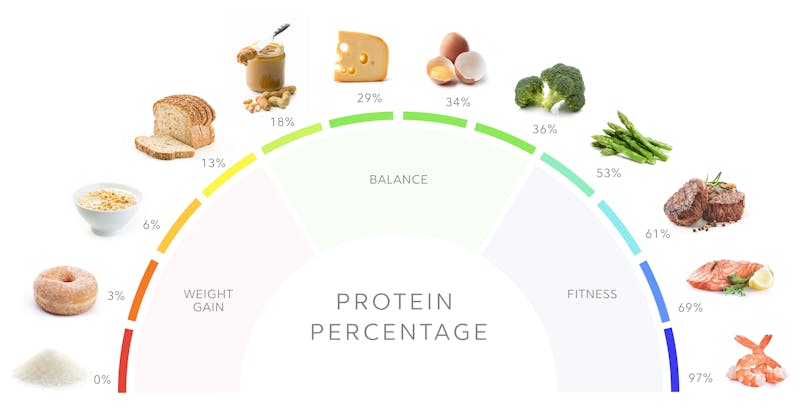



The best choices for high-protein diets are foods with a high protein percentage. The protein percentage of a food tells you how much protein per calorie a food has.6 Foods with a lot of protein and less fat and carbohydrate are ranked higher, as are low-fat, low-carb foods with a lot of fiber.
Foods in the middle range of protein percentage can help you maintain your weight and your muscle mass. Going a little higher — over 30 or 35% — may help you lose weight.
Foods with a lower protein percentage may lead to weight gain, while foods with the highest protein percentage may be good choices for someone who is really trying to reduce body fat and become lean and fit.
Fortunately, most high-protein foods are delicious and have plenty of vitamins and minerals, too. You can start with this list of the best high-protein foods.
- Meat and poultry: beef, chicken, lamb, turkey
- Seafood: shrimp, crab, salmon, tuna
- Eggs: whole eggs or egg whites
- Dairy: cottage cheese, greek yogurt
- Legumes: Beans, lentils, peas, and soy
- Non-starchy vegetables7: spinach, cauliflower, broccoli, mushrooms
If your diet consists mainly of the above foods, you are on your way to eating a healthy diet with plenty of protein.
Remember that non-starchy vegetables may have a high protein percentage, but they won’t give you the total protein, calories, or all the nutrients you need. Base your meals around a protein source — whether from animals or plants — and add high-protein-percentage vegetables for a little extra boost of amino acids, the building blocks of protein. Add just enough fat to make your meals delicious and filling. This approach will keep the total protein percentage of your meals high.
Here are a few tips to help you increase how much protein you eat and ensure you get adequate protein without adding too many unnecessary calories:
- Add extra egg whites to your scrambled eggs or omelets.
- Replace lower protein snacks, like nuts and cheese, with higher protein versions like lupini beans, zero-sugar jerky, or cold cuts.
- Include your favorite foods that are higher than 35% protein. Choose from the highest protein foods such as shrimp, chicken breasts, and lean cuts of meat.
- Swap higher fat cheese and yogurt with low-fat cheese or Greek yogurt. The lower-fat versions have higher protein percentages and therefore more protein per calorie.
You can find the protein percentage of many of your favorite foods and maybe discover a few new favorites, in our guide on the best high-protein foods for weight loss.
What about protein powders?
Although our bias is that you should get most of your protein from whole foods, protein powders can still be part of a healthy, high-protein diet.
You may not need protein powders if you prioritize the food on our list of best high-protein foods. But if you fall short of your daily targets, protein powders are an easy and convenient way to get more protein.
Plus, protein powders are a great way to create high-protein versions of your favorite desserts, low-carb bread, or smoothies.
If you are going to use protein powders, make sure they have few additives, such as sweeteners, maltodextrin, seed oils, or fillers.
Animal and plant protein powders are both good options, and you can choose which works best for your taste, preferences, and carbohydrate goals.
Summary
- Foods with the highest protein percentage are low in carbs and fat, like lean meat and seafood.
- To increase the protein in your diet, look for easy substitutions — snack on lupini beans or venison jerky, add two egg whites to your two whole eggs in the morning, or add more meat, seafood, dairy, or legumes to your meals.
- Mix protein foods with high-fiber vegetables – and don’t overdo fat – to create meals with a protein percentage above 35%.
- If you struggle to meet your protein goals with whole foods, consider protein powders.
3. High-protein benefits




Weight loss
Multiple studies demonstrate higher protein intake helps with weight loss, specifically fat mass loss. 8
Metabolic benefits
Studies show diets higher in protein contribute to better blood sugar control and improved insulin sensitivity when compared to lower protein diets.9 Can eating more protein raise insulin levels in an unhealthy way? Scientific studies don’t support this idea.
While protein may briefly increase insulin concentrations, high-protein diets are not known to cause chronic hyperinsulinemia (high insulin levels). In fact, for people with prediabetes or type 2 diabetes, a higher protein diet may be more beneficial than a lower protein one.10
Body composition
Higher protein diets promote lean muscle mass and encourage loss of fat mass.11
Strength, bone health, and preventing frailty
As people age, muscle mass and bone health decline, which, if not corrected, can lead to physical frailty along with an increased risk of falls and bone fractures.12 Eating more protein can counteract this trend toward frailty with improved muscle mass and bone health. 13
Satiety
Part of the reason for weight loss and better glycemic control could be protein’s ability to decrease hunger. Numerous studies show that as the protein amount increases, feelings of hunger and the amount of food eaten the rest of the day go down.14
4. How do we define a high-protein diet?
Summary: High-protein diets are:
- Diets with more than 20% of calories from protein
- Over 1.2 grams of protein per kilo of body weight
- Diets with more protein than the Recommended Daily Allowance (RDA), which is set at 0.8 grams per kilo.
There is no universally agreed-upon definition of a high-protein diet, and what you consider “high” may depend on where you start.
At Diet Doctor, we define high protein as over 1.2 grams per kilo per day or above 20% of calories. This really can be considered an adequate amount of protein, but since you may be eating less protein than what we recommend, you may think of our recommendation as a “high-protein diet.” We recommend that most people aim for 1.2 to 2 grams of protein per kilo or 20-35% of calories from protein.
Our definition of high protein is relative to The US Institute of Medicine, which sets 10% to 35% of calories as the acceptable range for protein intake. But it’s likely that you can safely eat much higher than 35% of your calories from protein.15
5. How much protein do I need?
Summary
- Calculate your daily protein goal based on your height, activity level, and health goals.
- We recommend a protein intake of 1.2 to 2.0 grams per kilo of reference body weight.
- If you are very physically active or taller than 6 feet, consider staying at the higher end of this range.
- Distribute your protein intake throughout the day, with 30 to 35 grams per meal for women and 45 for men, if you are eating three meals a day.
The first step in eating a higher protein diet is setting your protein targets. We recommend 1.2 to 2.0 grams per kilo of reference body weight per day.16 That usually equates to around 30% of your calories from protein.
If you are very physically active, over 50 years old, or most of your protein comes from plant sources, we recommend aiming for the higher end of the protein range (above 1.5 grams per kilo per day).
6. Try a high-protein diet yourself
Why should you consider a higher protein diet? Eating more protein can help with weight loss, body composition, metabolic health, satiety, strength, and more.
Diet Doctor has all the information you need to learn more about high-protein diets. You can create your own high protein plan with our recipes or use one of our high protein meal plans for effective weight loss.
American Journal of Clinical Nutrition 2008: Protein, weight management, and satiety [overview article; ungraded] ↩
American Journal of Clinical Nutrition 2006: The underappreciated role of muscle in health and disease [overview article; ungraded] ↩
Applied physiology, nutrition, and metabolism 2016: Protein “requirements” beyond the RDA: implications for optimizing health [overview article; ungraded]
The RDA is defined as the “average daily level of intake sufficient to meet the nutrient requirements of nearly all (97%-98%) healthy people.” The RDA for protein is 0.8 grams per kilo of reference body weight. But, as we explain in this guide, that is likely too low for most people who want to improve their health.
↩American Journal of Clinical Nutrition 2008: Protein in optimal health: Heart disease and type 2 diabetes [overview article; ungraded] ↩
American Journal of Clinical Nutrition 2008: Role of dietary protein in the sarcopenia of aging [overview article; ungraded]
American Journal of Clinical Nutrition 2008: Amount of type of protein influences bone health [overview article; ungraded]
↩We don’t include calories from fiber in our calculations, as the number normally is very small, plus fiber generally has positive effects on satiety. ↩
These are high in protein percentage, although low in overall protein amounts ↩
The first study reports improved body composition and weight loss with no reduction in fat-free mass or resting energy expenditure on a high-protein diet in overweight women.
Nutrients 2018: Effects of adherence to a higher protein diet on weight loss, markers of health, and functional capacity in older women participating in a resistance-based exercise program [randomized trial; moderate evidence]
The following study, a 12-week intervention in obese women, also reports more significant fat mass loss with a 25% protein diet than a 15% protein diet.
British Journal of Nutrition 2020: The effect of 12 weeks of euenergetic high-protein diet in regulating appetite and body composition of women with normal-weight obesity: a randomised controlled trial [randomized trial; moderate evidence]
And the next two examples also report similar results:
International Journal of Obesity Related Metabolic Disorders 2004:
Effect of normal-fat diets, either medium or high in protein, on body weight in overweight subjects: a randomised 1-year trial[randomized trial; moderate evidence]Endocrine, Metabolic, and Immune Disorders of Drug Targets 2020:
Effects of a low carb diet and whey proteins on anthropometric, hematochemical, and cardiovascular parameters in subjects with obesity [nonrandomized study, weak evidence]The last example is a review of RCTs showing better weight loss in those following higher protein, low-fat, energy-restricted diets compared to lower protein versions of similar diets.
American Journal of Clinical Nutrition 2012: Effects of energy-restricted high-protein, low-fat compared with standard-protein, low-fat diets: a meta-analysis of randomized controlled trials [systematic review of randomized trials; strong evidence]
↩This RCT reports that those following a 27% protein diet compared to 16% had better preservation of lean mass and a better glycemic response despite no difference in weight loss.
Nutrients 2018: Effects of adherence to a higher protein diet on weight loss, markers of health, and functional capacity in older women participating in a resistance-based exercise program [randomized trial; moderate evidence]
This randomized crossover study reports subjects with type 2 diabetes had a more significant reduction in A1c and total daily glucose, fatty liver, and fatty pancreas with a 30% carb/30% protein diet compared to a 50% carb/17% protein diet.
Diabetologia 2019: A carbohydrate-reduced high-protein diet improves HbA 1c and liver fat content in weight stable participants with type 2 diabetes: a randomised controlled trial [randomized trial; moderate evidence]
This small RCT reports 100% prediabetes remission with a higher protein diet.
Nutrition, Metabolism, and Cardiovascular Diseases 2020: High-protein diet leads to prediabetes remission and positive changes in incretins and cardiovascular risk factors
↩
[randomized trial; moderate evidence]Diabetes care 2003: Amino acid ingestion strongly enhances insulin secretion in patients with long-term type 2 diabetes. [nonrandomized trial; weak evidence] ↩
Nutrients 2019: Dietary protein and muscle mass: translating science to application and health benefit [overview article; ungraded]
Advances in Nutrition 2019: Recent advances in the characterization of skeletal muscle and whole-body protein responses to dietary protein and exercise during negative energy balance [overview article; ungraded]
Nutrients 2018: Recent perspectives regarding the role of dietary protein for the promotion of muscle hypertrophy with resistance exercise training [overview article; ungraded]
↩The following review reports an age-related gradual loss of muscle mass after age 50:
Clinical and Experimental Pharmacology and Physiology 2007: Age-related changes in the structure and function of skeletal muscles [overview article; ungraded]
And the following 14-week intervention study reports that subjects ages 55 to 77, who ate the RDA protein level of 0.8 grams per kilo per day, decreased muscle mass despite not losing any weight.
Journal of Gerontology Biological Science and Medical Science 2001: The recommended dietary allowance for protein may not be adequate for older people to maintain skeletal muscle [randomized trial; moderate evidence]
This review discusses the age-related changes in both muscle and bone.
Physiology 2015: Aging and the muscle-bone relationship
↩
[overview article; ungraded]The following reviews summarize the evidence for this nicely.
Nutrients 2016: Protein consumption and the elderly: What is the optimal level of intake? [overview article; ungraded]
American Journal of Clinical Nutrition 2015: Protein and healthy aging [overview article; ungraded]
The following observational study reports a high association between eating more protein and having less disability with aging.
Journal of the American Geriatrics Society 2019: Protein intake and disability trajectories in very old adults: The Newcastle 85 Study [observational study with HR over 2, weak evidence]
Higher protein intake, especially when eating animal foods, is associated with greater muscle mass and the lowest functional decline risk.
Journal of Gerontology Biological Science and Medical Science 2017: High-protein foods and physical activity protect against age-related muscle loss and functional decline [nutritional epidemiology study; very weak evidence]
Subjects ages 70 to 79 eating more protein lost 40% less muscle mass compared to those who ate less:
American Journal of Clinical Nutrition 2008: Dietary protein intake is associated with lean mass change in older, community-dwelling adults: the Health, Aging, and Body Composition (Health ABC) Study
[nutritional epidemiology study with HR<2; very weak evidence]One randomized trial and a large observational study report better bone health in those who ate more protein.
Journal of Bone and Mineral Research 2011: A real and volumetric bone mineral density and geometry at two levels of protein intake during caloric restriction: a randomized, controlled trial
[ moderate evidence]Journal of Bone and Mineral Research 2000:
Effect of dietary protein on bone loss in elderly men and women: the Framingham Osteoporosis Study [nutritional epidemiology study with HR<2; very weak evidence]The following observational study reports a significantly increased risk of dying after a hip fracture.
American Journal of Epidemiology 1993:
↩
Population-based study of survival after osteoporotic fractures [observational study, weak evidence]Protein and satiety
American Journal of Clinical Nutrition 2008: Protein, weight management, and satiety [overview article; ungraded]
Increasing protein from 15% to 30% resulted in a significant caloric drop.
American Journal of Clinical Nutrition 2005: A high-protein diet induces sustained reductions in appetite, ad libitum caloric intake, and body weight despite compensatory changes in diurnal plasma leptin and ghrelin concentrations [nonrandomized study, weak evidence]
↩Institute of Medicine of the National Academies 2005: Dietary reference intakes for energy, carbohydrate, fiber, fat, fatty acids, cholesterol, protein, and amino acids [overview article; ungraded]
Journal of the American Dietetic Association 2002: Dietary reference intakes for energy, carbohydrate, fiber, fat, fatty acids, cholesterol, protein and amino acids [overview article; ungraded]
Controversy exists about how they derived the upper limit, as it uses nitrogen balance and is not based on clinical outcomes; it is therefore theoretical and could be even higher.
Journal of Nutrition 2003: Amino acid pharmacokinetics and safety assessment [overview article; ungraded]
Based on calculations of the liver and kidney’s ability to safely handle protein, a 176-pound (80-kilo) person has a theoretical maximum of 365 grams of protein per day. That’s 73% of a 2,000 calorie diet! It’s safe to say that most people won’t have to worry about eating too much protein.
International Journal of Sports Nutrition and Exercise Metabolism 2006: A review of issues of dietary protein intake in humans [overview article; ungraded]
↩What’s your reference body weight? Reference body weight is an estimate of what your lean body mass should be based on your height. You can find your reference body weight and protein ranges on our reference page. We use reference body weight rather than total body weight since a 5 foot (154 cm) tall woman who weighs 200 pounds (90 kilos) technically should have the same protein requirements as one who weighs 140 pounds (63 kilos). ↩





